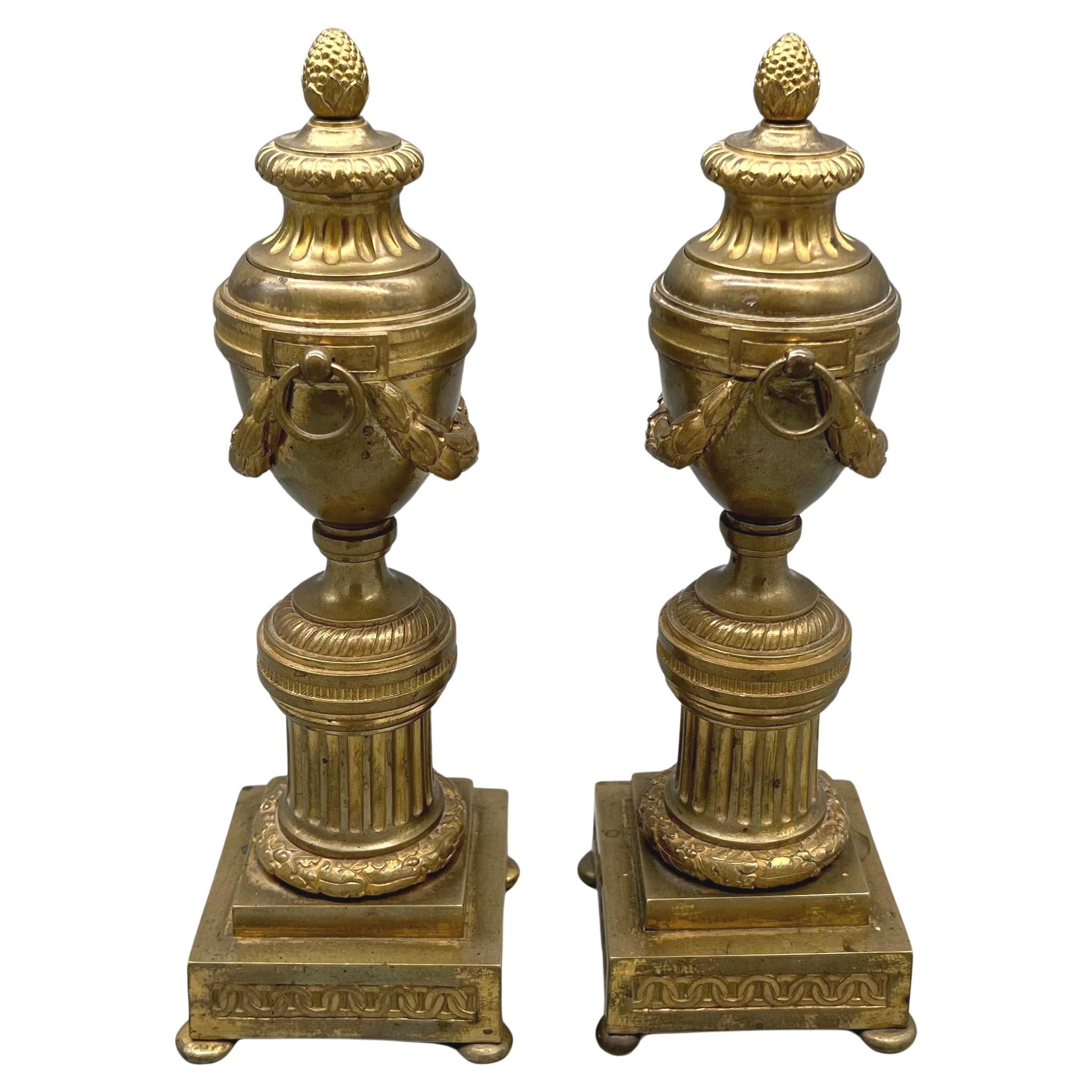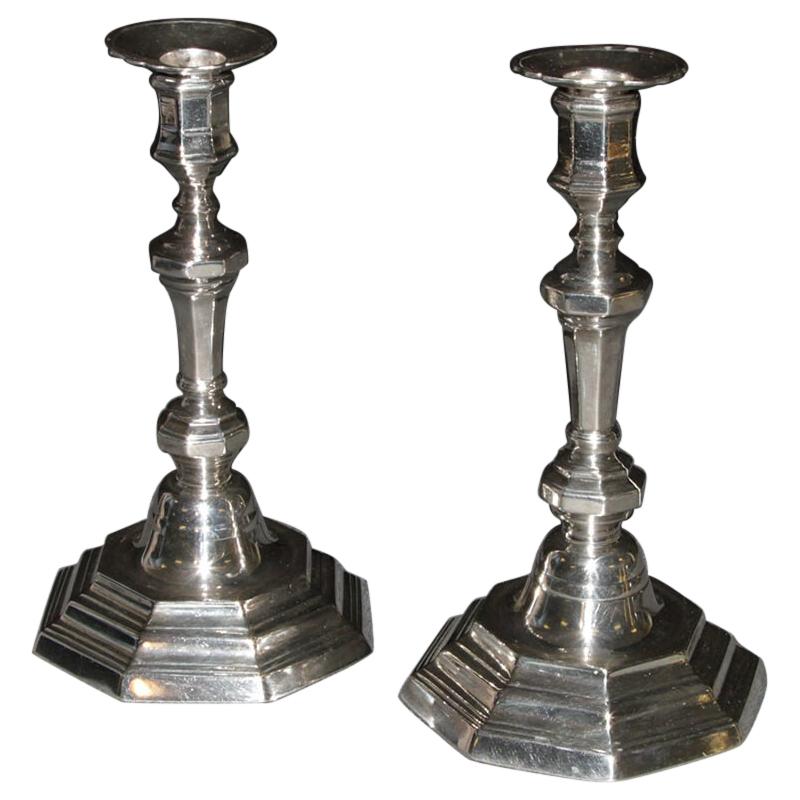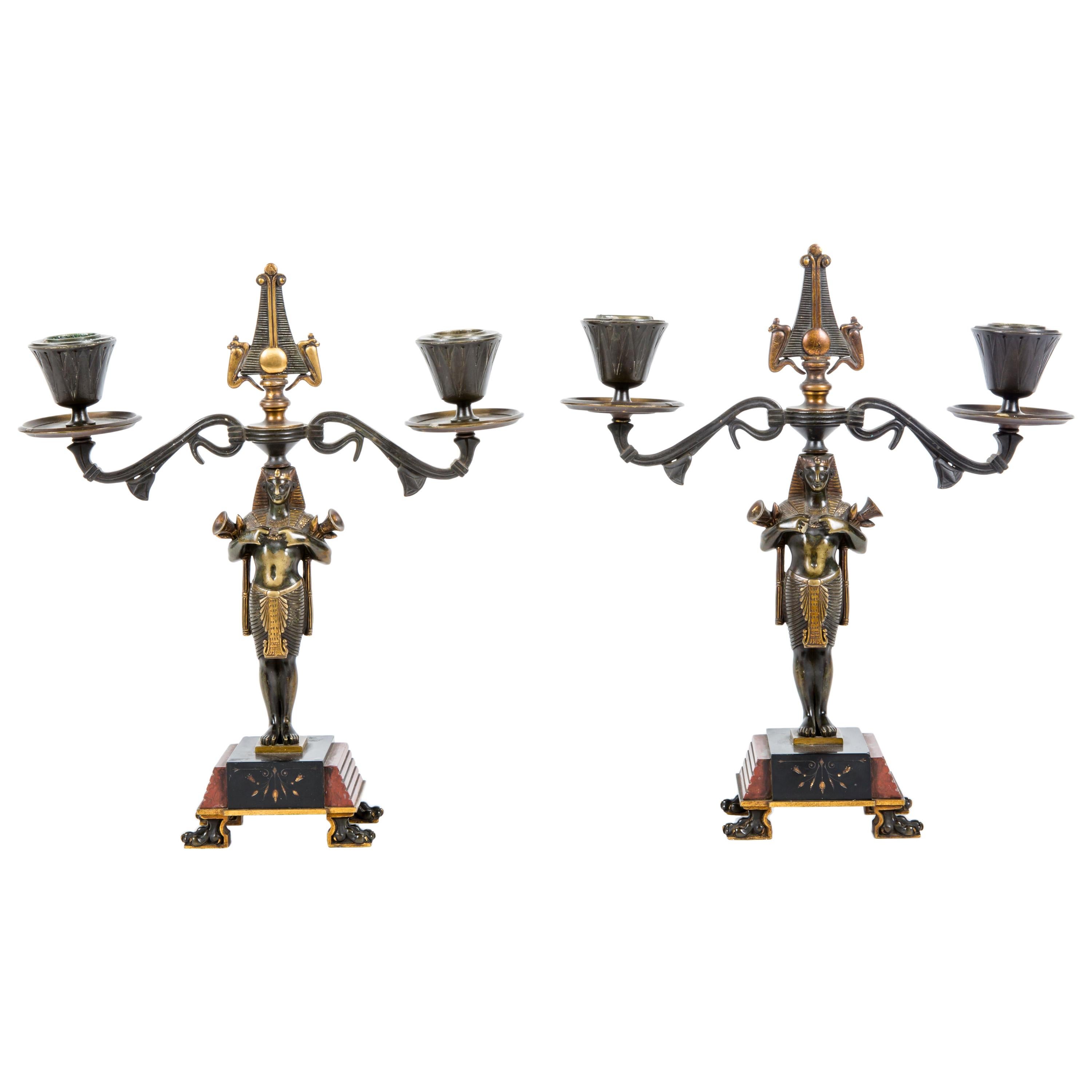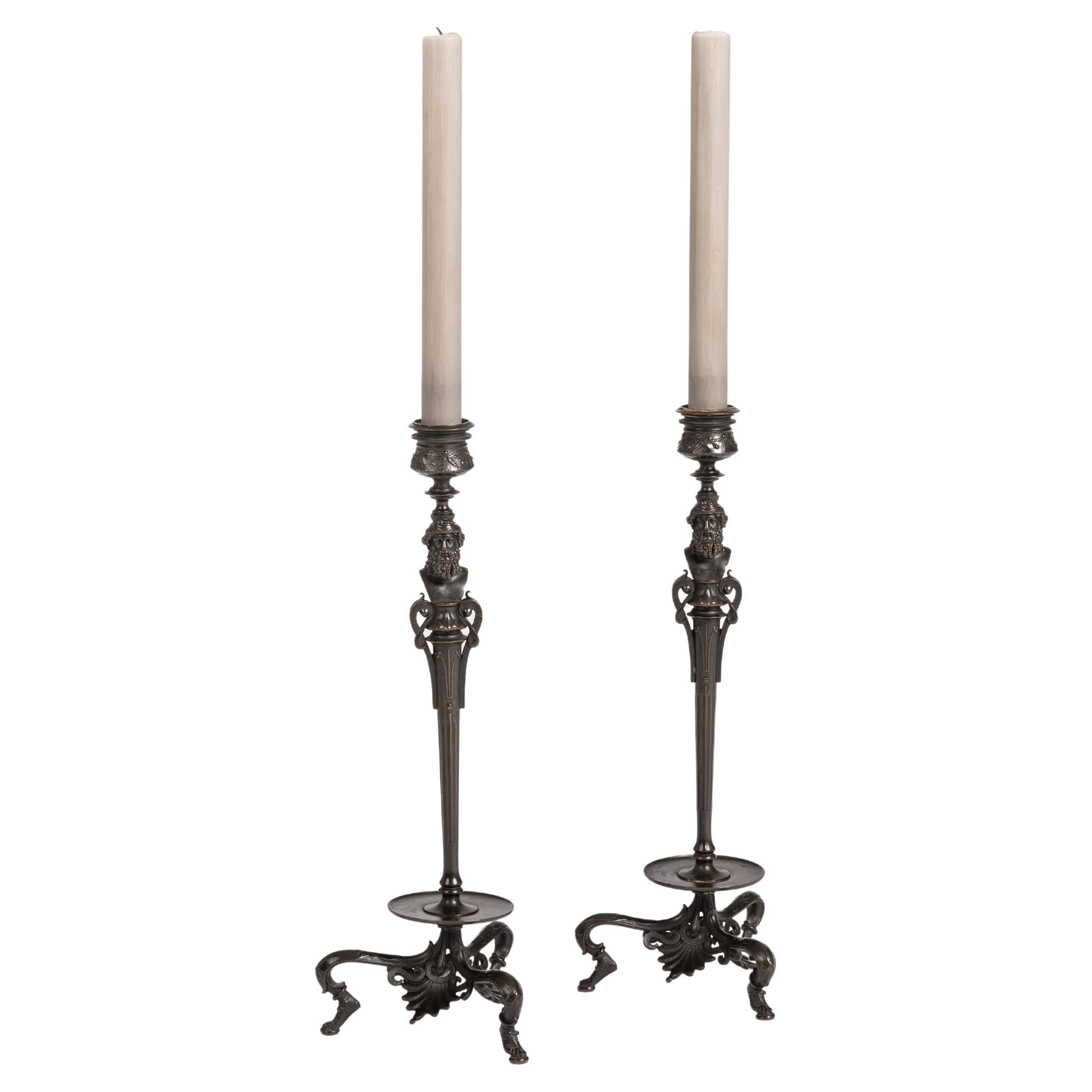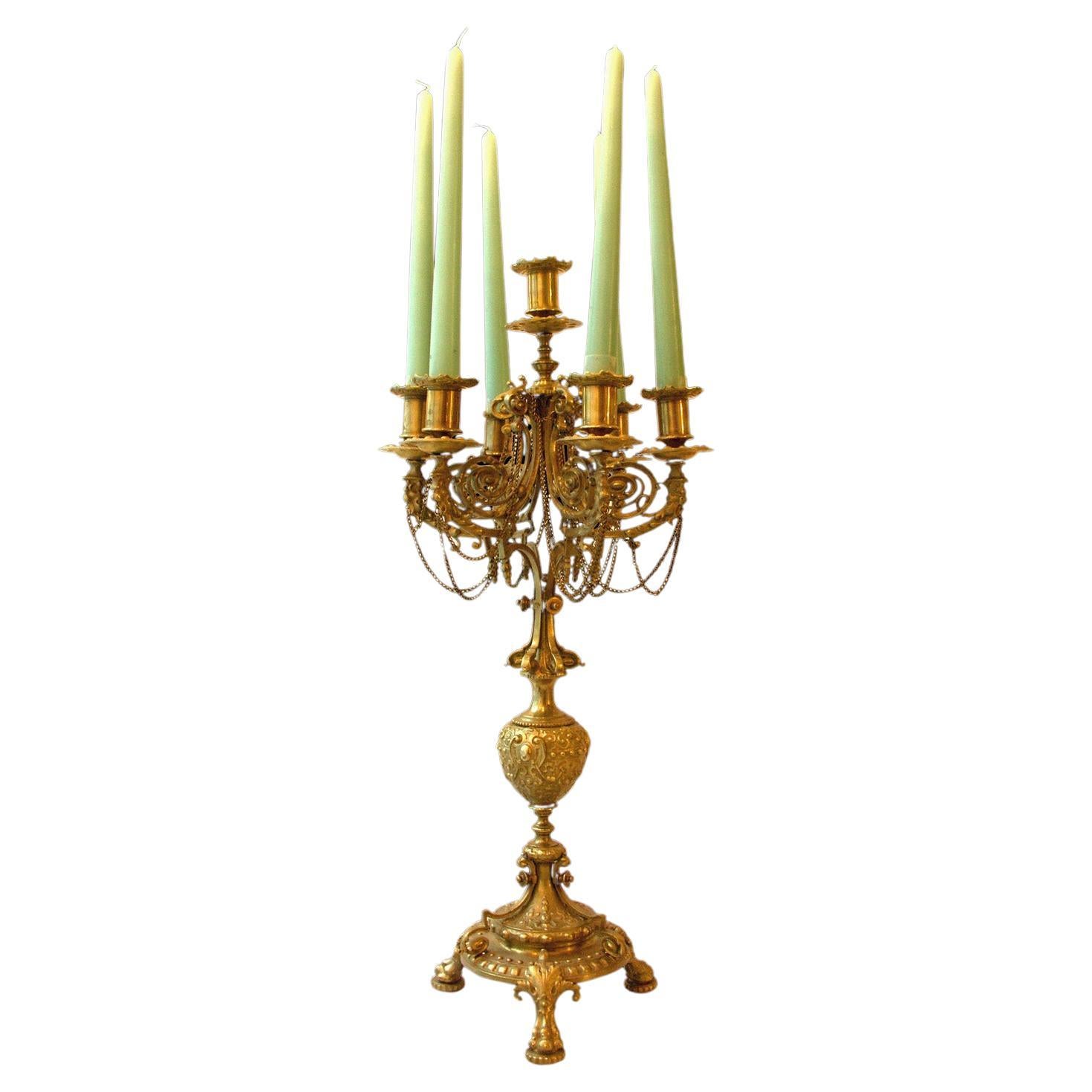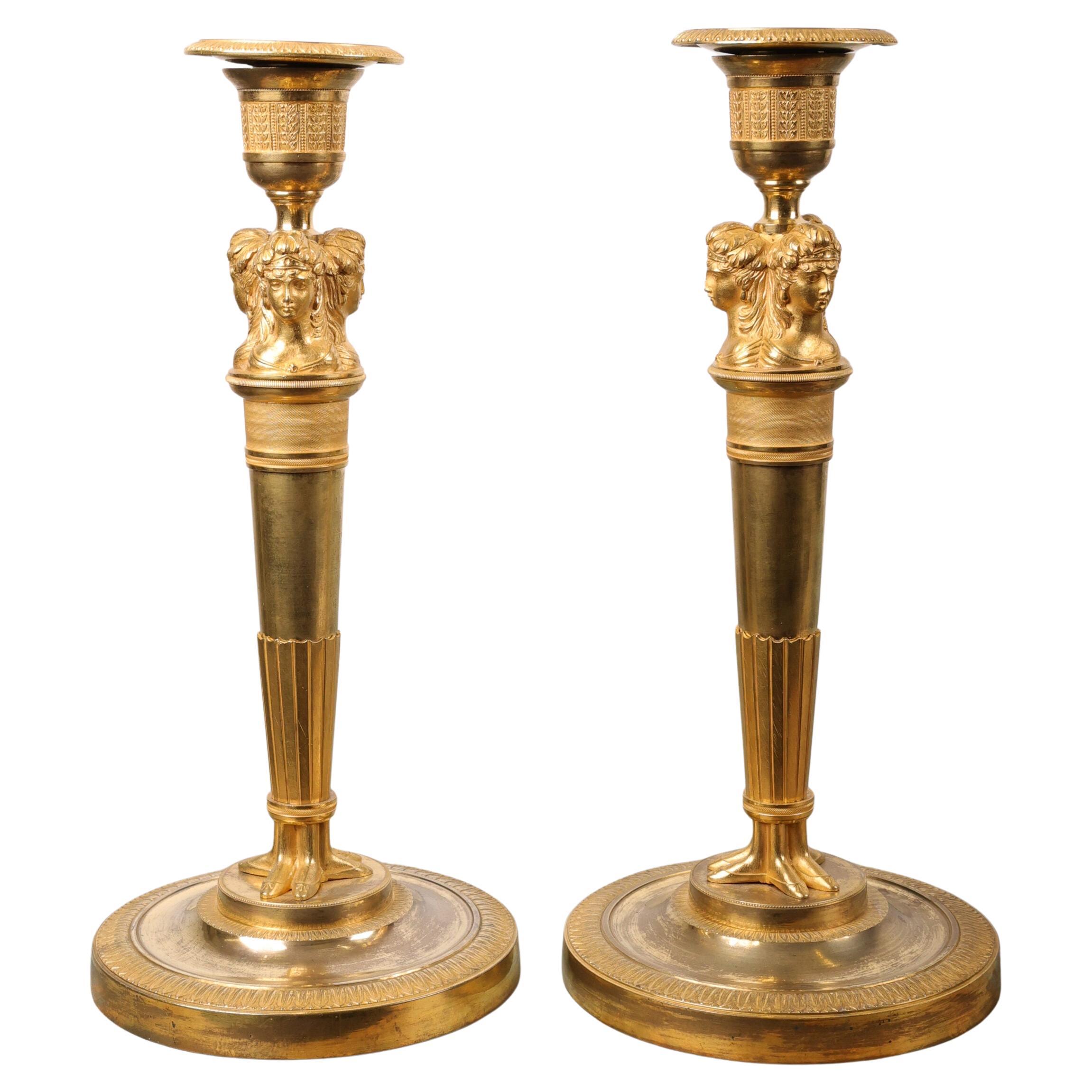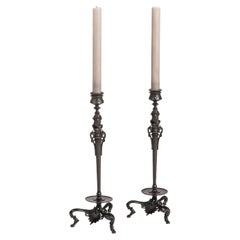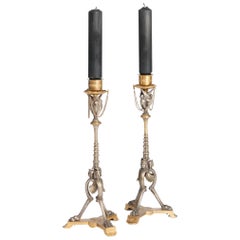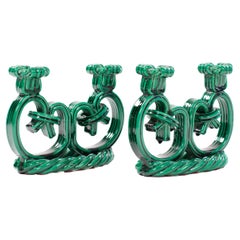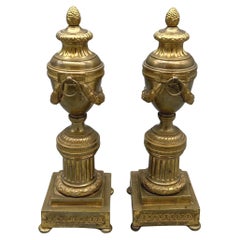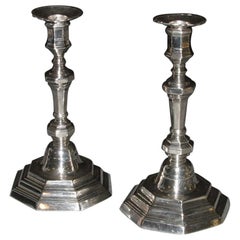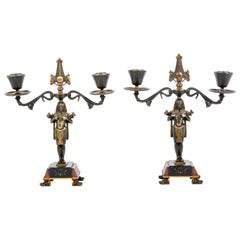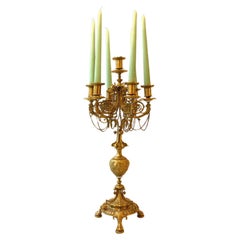Items Similar to Pair of Louis Seize Fire Gilded Candlesticks France 1800 by F. Barbedienne
Want more images or videos?
Request additional images or videos from the seller
1 of 6
Pair of Louis Seize Fire Gilded Candlesticks France 1800 by F. Barbedienne
About the Item
Pair of strict classicistical fire gilded candlesticks France 1840, signed Barbedienne.
Strict classicist design with square base, flowers and leaf ornaments in different finish. Decorated and smooth elements in alternation create otically balanced object.
The widest part of the stem is 4.0cm
Ferdinand Barbedienne (* August 6, 1810 in Saint-Martin-de-Fresnay, Calvados department, France; † March 21, 1892 in Paris) was a French sculptor, bronze ware manufacturer, and gallery owner. One of the most important and popular Éditeurs d'art, or publishers of art articles, he had most of the French sculptors of his time under contract.
Life and work
Ferdinand Barbedienne was the son of a farmer. At the age of 13, he learned the Craft of saddlery.
In 1822 he moved to Paris, where he first worked as a clerk in a wallpaper shop. He received start-up capital from his employer to open his own store, which he set up on Rue Notre-Dame-de-Lorette in 1834. He pursued the idea of exhibiting bronze statues in addition to his core business and mass producing them in small format.
In 1838, he joined forces with the mechanic Achille Collas, who had developed the machine á reduction (réducteur for short); a device based on the principles of the pantograph that could reproduce three-dimensional objects in any size - reduced or enlarged. On November 29, 1838, both signed the founding contract for the company Société Ferdinand Barbedienne et Achille Collas, which aimed to commercially exploit the mechanized production of sculptural works for an initial 20 years. Barbedienne took care of the commercial management of the company, while Collas contributed the patent on his invention and seven existing machines, and with his profound knowledge of machinery was responsible for the production processes. Together they decided on the subject matter of the objects, the selling prices, and all other financial matters.
In 1841, they produced casts of the Apollo of Belvedere, the Spinario, and 21 pieces with the motif of a bas-relief of the Parthenon. These were followed by versions of the Laocoon group, the Venus of Arles, and the Borghese Fencer, among others. Special interest was initially shown in works from antiquity, for which casts from the Atelier de Moulage in the Louvre served as models. The company continued to produce works by representatives of the Renaissance such as Michelangelo, Donatello, Giovanni Bologna or by French sculptors such as Jean Goujon, Jean-François Flamand, Pierre Puget, François Girardon, Antoine Coysevox, Christophe-Gabriel Allegrain, Étienne-Maurice Falconet, Jacques Caffieri, Jean-Antoine Houdon and others. Great interest was also shown in works by well-known contemporary artists, with prizes received such as the Prix de Rome, membership in the Société des Artistes Français, or awards of the Cross of the Legion of Honor being some of the selection criteria.
In 1843, Barbedienne signed his first publishing contract with François Rude for the serial reproduction of a contemporary artist's works for the artist's lifetime, which quickly brought the company international renown. The first catalog was printed that same year, with others following about every two to three years. In 1847, the company established a foundry in Paris, whereupon Barbedienne became a member of the Réunion des Fabricants. Despite some difficulties during the February Revolution of 1848, the company's activities expanded, and it now turned to the manufacture of decorative arts objects such as mantelpieces, chandeliers, and candelabras. At that time, the Barbediennes store was located on Boulevard Poissoniére, and the workshop on Rue de Lancry. In 1851 he signed a contract with sculptor Jules Cavelier for an unlimited edition of his work Pénélope, which - originally created as Femme grecque endormie in 1842 - earned Barbedienne two Grand Médailles at the 1851 Great Exhibition in London. At the 1855 Paris Universal Exhibition, he received the Grand Médaille d'Honneur and eleven Médailles de Coopérateurs. During this period, Barbedienne secured the exclusive right of ownership and reproduction for the entire oeuvre of Auguste Clésinger. Barbedienne's biggest competitor was considered to be the Susse Frères foundry.
In 1859 Achille Collas died, whereupon Barbedienne continued to run the company alone with 300 workers. He received further awards at the London World's Fair in 1862. In 1865, he was elected president of the Réunion des Fabricants and held this position until 1885. In 1874, Barbedienne was admitted to the Legion of Honor as a commander. To compete with Japanese imports, which were in vogue at the time, Barbedienne experimented with new techniques for applying champlevé enamel and partitioned enamel between 1860 and 1890. During the Franco-Prussian War of 1870-71, the company made 70 cannons for the French Ministry of Defense.
After his death in 1892, Barbedienne was buried in the Père Lachaise cemetery. By then he had received numerous awards. By the time of his death, his company employed 600 workers and had produced some 3000 objects of art as well as decorative art objects in bronze. His products were also known and in demand abroad. He was one of the most important and popular manufacturers of bronzes, having contracted most of the sculptors of his time, including Antoine-Louis Barye, Barye le fils, Émile-Coriolan Guillemin, François Joseph Bosio, Jean-Baptiste Carpeaux, Henri Chapu, Pierre Jean David D'Angers, Emmanuel Frémiet, François Jouffroy and Auguste Rodin.
After his death, the company was continued by his nephew Gustave Leblanc-Barbedienne, who had previously been appointed as a partner. Leblanc-Barbedienne established sales branches in the United States of America, the Netherlands, the United Kingdom and Germany in 1913, although the demand for Industrial small sculptures was already declining. In the United Kingdom, the company worked with Jackson & Graham in London and Thomas Agnew & Sons in Manchester and Liverpool, and in the United States with the Bigelow-Kennard company in Boston and Tiffany & Co. in New York City. The company was discontinued in 1954.
- Dimensions:Height: 11.42 in (29 cm)Width: 3.94 in (10 cm)Depth: 3.94 in (10 cm)
- Sold As:Set of 2
- Style:Louis XVI (Of the Period)
- Materials and Techniques:
- Place of Origin:
- Period:
- Date of Manufacture:1799
- Condition:
- Seller Location:Salzburg, AT
- Reference Number:1stDibs: LU2438328084402

About the Seller
5.0
Vetted Professional Seller
Every seller passes strict standards for authenticity and reliability
Established in 2000
1stDibs seller since 2016
88 sales on 1stDibs
Typical response time: 2 hours
- ShippingRetrieving quote...Shipping from: Salzburg, Austria
- Return Policy
Authenticity Guarantee
In the unlikely event there’s an issue with an item’s authenticity, contact us within 1 year for a full refund. DetailsMoney-Back Guarantee
If your item is not as described, is damaged in transit, or does not arrive, contact us within 7 days for a full refund. Details24-Hour Cancellation
You have a 24-hour grace period in which to reconsider your purchase, with no questions asked.Vetted Professional Sellers
Our world-class sellers must adhere to strict standards for service and quality, maintaining the integrity of our listings.Price-Match Guarantee
If you find that a seller listed the same item for a lower price elsewhere, we’ll match it.Trusted Global Delivery
Our best-in-class carrier network provides specialized shipping options worldwide, including custom delivery.More From This Seller
View AllPair of French Napoleon III Bronze Candlesticks by Foundry F. Barbedienne 1860s
By F. Barbedienne Foundry
Located in Salzburg, AT
Pair of very elegant classicist candlesticks in fine patinated bronze, signed BARBEDIENNE.
The execution of the casting is extremely finely worked with delicate leaves on the outer wall of the candlestick, with a head of antiquity on the upper part of the stem which flows into the lower part with fluting and side volutes.
The 3 curved legs stand on raised feet with delicate strappy sandals.
Measures: The diameter at the top is 3.5cm and at the bottom 13.5cm
Ferdinand Barbedienne (* August 6, 1810 in Saint-Martin-de-Fresnay, Calvados department, France; † March 21, 1892 in Paris) was a French sculptor, bronze ware manufacturer, and gallery owner. One of the most important and popular Éditeurs d'art, or publishers of art articles, he had most of the French sculptors of his time under contract.
Life and work
Ferdinand Barbedienne was the son of a farmer. At the age of 13, he learned the Craft of saddlery.
In 1822 he moved to Paris, where he first worked as a clerk in a wallpaper shop. He received start-up capital from his employer to open his own store, which he set up on Rue Notre-Dame-de-Lorette in 1834. He pursued the idea of exhibiting bronze statues in addition to his core business and mass producing them in small format.
In 1838, he joined forces with the mechanic Achille Collas, who had developed the machine á reduction (réducteur for short); a device based on the principles of the pantograph that could reproduce three-dimensional objects in any size - reduced or enlarged. On November 29, 1838, both signed the founding contract for the company Société Ferdinand Barbedienne et Achille Collas, which aimed to commercially exploit the mechanized production of sculptural works for an initial 20 years. Barbedienne took care of the commercial management of the company, while Collas contributed the patent on his invention and seven existing machines, and with his profound knowledge of machinery was responsible for the production processes. Together they decided on the subject matter of the objects, the selling prices, and all other financial matters.
In 1841, they produced casts of the Apollo of Belvedere, the Spinario, and 21 pieces with the motif of a bas-relief of the Parthenon. These were followed by versions of the Laocoon group, the Venus of Arles, and the Borghese Fencer, among others. Special interest was initially shown in works from antiquity, for which casts from the Atelier de Moulage in the Louvre served as models. The company continued to produce works by representatives of the Renaissance such as Michelangelo, Donatello, Giovanni Bologna or by French sculptors such as Jean Goujon, Jean-François Flamand, Pierre Puget, François Girardon, Antoine Coysevox...
Category
Antique 1860s French Napoleon III Candlesticks
Materials
Bronze
Pair of French Napoleon III Candlesticks Bronze & Bronze Firegilt by A. Daubrée
By Alfred Daubrée
Located in Salzburg, AT
Pair of French Napoleon III candlesticks in bronze and bronze fire gilt designed, manufactured and signed by Alfred Daubrée, Nancy.
The cast bronze body...
Category
Antique 1860s French Napoleon III Candlesticks
Materials
Bronze
Pair of Modern, Heavy Brass Candlesticks by Bernt Karlsson by Gusum 1980, signed
Located in Salzburg, AT
Pair of purist candleholders in solid brass, designed by Bernt Karlsson for Gusum - Metallslöjden (metalworking company), Sweden.
Designed by the talented Bernt Karlsson, these cand...
Category
Vintage 1980s Swedish Modern Candlesticks
Materials
Brass
Pair of French Art Déco Ceramic Candlesticks in Fir Green Cord Look 1930s
Located in Salzburg, AT
Pair of French Art Déco Ceramic Candlesticks in Fir Green Cord Look 1930s
The candle holders have the appearance of a twisted rope or cord.
The moulded, raised cord is oval at the b...
Category
Vintage 1930s French Art Deco Candlesticks
Materials
Ceramic
Pair of Modern, Heavy Brass Candlesticks by Lars Bergsten for Gusum 1985, signed
By Lars Bergsten
Located in Salzburg, AT
Pair of purist candleholders in solid brass, designed by Lars Bergsten for Gusum - Metallslöjden (metalworking company), Sweden.
Designed by the talented Lars Bergsten, these candle...
Category
Vintage 1980s Swedish Modern Candlesticks
Materials
Brass
Set of 3 High Black Ebonized Carved French Napoleon III Candlesticks 1860s
Located in Salzburg, AT
Set of 3 large black ebonized French Napoleon III candlesticks.
The turned candlesticks have an elegant siluette the slightly higher base of 15cm diameter and 7cm height on 3 small round baroque feet forms the base. The conical, slender central base is inlaid at the bottom with a triple turned baluster stem and at the top with a turned plate as a subdivision and on a small baluster above it the slender and elongated candlestick stem.
The set of 3 candlesticks...
Category
Antique Mid-19th Century French Napoleon III Candlesticks
Materials
Wood
You May Also Like
Pair of LXVI candlestick-cassolettes, France, circa 1800
Located in Paris, FR
Pair of ormolu candlestick- cassolettes in the form of covered pedestal pots with neo-classical laurel garland decoration, on shafts in the form of sections of antique columns on a q...
Category
Antique Early 1800s French Louis XVI Candlesticks
Materials
Bronze
Pair of French Louis XVI Candlesticks
Located in Westwood, NJ
A fine and rare pair of French Louis XVI silvered bronze candlesticks.
The seemed sticks with a bright polished finish and with removable bobeches.
France, ca 1780
Dimensions...
Category
Antique Late 18th Century French Louis XVI Candlesticks
Materials
Bronze
Ferdinand Barbedienne Pair of French Egyptian Revival Figural Candlestick
Located in New York, NY
Pair of French Egyptian Revival candelabra by Ferdinand Barbedienne (France, 1810-1892)
Two-arm candleholder extends above a stylistic Egyp...
Category
Antique 19th Century French Egyptian Revival Figurative Sculptures
Materials
Bronze
Pair of Original Historistic Candlesticks Candle Holder Louis Seize Style
By Woka Lamps
Located in Vienna, AT
Historistic candlesticks rich engraved and decorated two pieces in the Louis Seize style.
Category
Antique 19th Century Austrian Gothic Revival Candle Holders
Materials
Brass
Pair of French Fire-Gilded Empire Candleholders
Located in Ljungby, SE
A pair of French fire-gilded Empire candleholders from around 1800-1810. The candleholders are in the Egyptianizing style that was popular at the time, referencing Napoleon's campaig...
Category
Antique Early 1800s French Empire Candlesticks
Materials
Bronze
$6,000 / set
Pair of French Fire-Gilded Charles X Candleholders
Located in Kastrup, DK
An elegant pair of Charles X candlesticks in fire-gilded and dark-patinated bronze, crafted in France around 1820.
The design features tapered stems adorned with finely cast acanthu...
Category
Antique Early 19th Century French Empire Candlesticks
Materials
Bronze
Recently Viewed
View AllMore Ways To Browse
1851 Great Exhibition
Gilded Furniture Ornaments
Gilded Cross
Flower Chandelier Candle
18th Century Gold Crosses
American Gilded Age Furniture
French Bronze Bas Reliefs
F Hall Artist
Antoine Louis Barye Bronzes
David French Bronze Sculpture
Japanese Shop Sign
Small Cannon
Dining Sets From 1800
Louis Saint Jacques
Antique Bronze Ware
Dining Room Tiffany Chandelier
Antique French Wallpaper
Bronze Statue Germany
